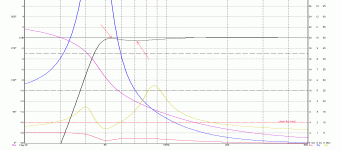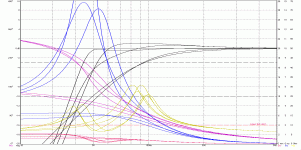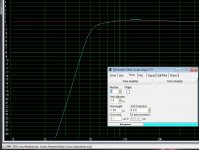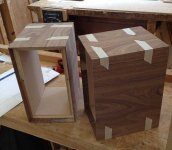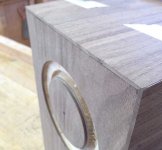I've attached a couple photos for you to take a look at. Let me know if you see any discrepancies in the parameters that I'm not seeing that may be causing it to not show the frequency response rising above zero.
Thanks,
Steven
Does winisd allow for modelling of stuff in a vented box? I know unibox does and I find (in the model and audibly) that adding stuffing to a response like you have there can mellow out the tuning peak.
well FWIW, Dave uses an older Mac based program ( I just asked him while multi-tasking, and promptly forgot - but let's just say it runs on OS9), so the results might not be graphically presented exactly the same as newer programs
and in any case, part of the experience is in knowing when /how to work around program defaults to achieve specific in situ results in known venues - as opposed to technically correct in cyberspace theoretical rooms.
I really believe using eq is the best way to accomplish StevenZ goals, in the nearfield.
I recently brought home my desktop speakers just to see how much difference it makes. In 7L sealed the cones were having a wild ride at mild listening levels WITHOUT the boost . At my desk, it's a challenge to make them visibly move. And the bass is nice.
. At my desk, it's a challenge to make them visibly move. And the bass is nice.
I've actually been thinking of upgrading to the alp7s. To many other things to buy
I recently brought home my desktop speakers just to see how much difference it makes. In 7L sealed the cones were having a wild ride at mild listening levels WITHOUT the boost
I've actually been thinking of upgrading to the alp7s. To many other things to buy
Chris, I appreciate the input. I think one might be confused about my goals here. As of right now I'm using them nearfield in my office, but my plans are to build a nice hefty bookshelf for them to run in a small listening room I've got at the house. I've tried them in the Pensil enclosures and got good results but am interested in building bookshelf enclosures at the moment as I have a really nice subwoofer I'd like to couple with them to fill out the bottom end.
Touching on the response from WinISD, you're correct. Sometimes we need to tweak and adjust to get the proper results. This is a perfect example of that. I let the program model up a box based on the driver parameters and it gave me something like .375 (?)ft enclosure and tuned it at about 58hz. I then increased the enclosure size to .5 and played with the tuning. Doing this resulted in a better looking response as well as being able to go down to 50hz theoretically. I'll wait until Dave replies to move forward on this project.
Cheers,
Steven
Touching on the response from WinISD, you're correct. Sometimes we need to tweak and adjust to get the proper results. This is a perfect example of that. I let the program model up a box based on the driver parameters and it gave me something like .375 (?)ft enclosure and tuned it at about 58hz. I then increased the enclosure size to .5 and played with the tuning. Doing this resulted in a better looking response as well as being able to go down to 50hz theoretically. I'll wait until Dave replies to move forward on this project.
Cheers,
Steven
Ah ok. Yup, I didn't understand that. Don't do what I do then if using it in your living room. If using a sub though, you may not need the extra bass extention. Just a thought if you want to save yourself some build time.
You may be right. But for those late night listening sessions I'd like to run without a sub but still have a bit of bottom end. That's where the ported enclosure comes in handy.
Cheers,
Steven
From what I'm seeing in WinISD is that it never crosses 0 even with those two figures I gave you.
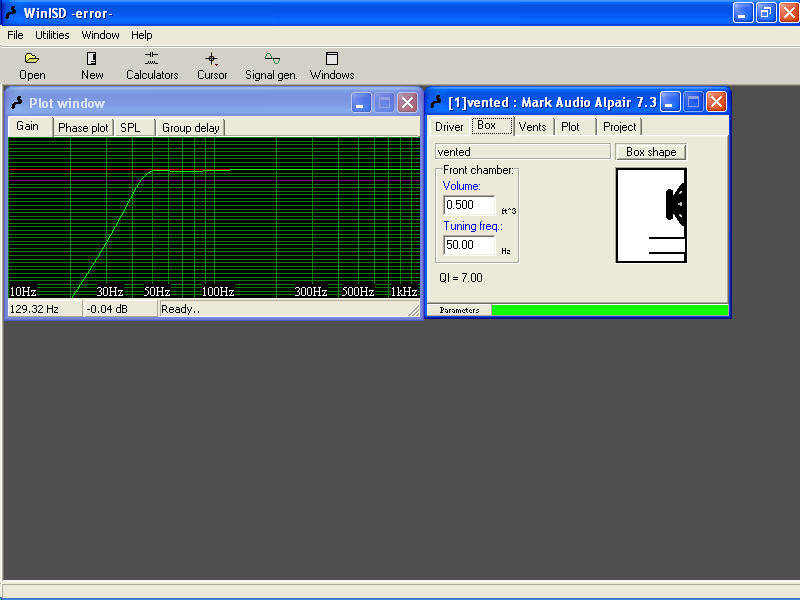
The graph is too small to do a good illustration, but the 1st derivative clearly crosses zeo twice in this chart. Post a bigger picture and i'll annotate. (also is it possible to change the colour scheme so that the FR curve is different from the graticle?
dave
well FWIW, Dave uses an older Mac based program ( I just asked him while multi-tasking, and promptly forgot - but let's just say it runs on OS9)
John Murphy's.He abandoned the Mac, it only runs in Windows now. It does a good job of charting.
dave
Why not just punch a 1.5" dia. hole in your existing boxes, and stick a couple pieces of plastic plumbing pipe in as an experiment. Tune the box at 55Hz, and you should get about the same F3.
Lookin gat the curves generated that was the one i liked. 1" ID pipe 54mm long (1.5" starts earing too much internal volume).
dave
Member
Joined 2009
Paid Member
Dave is the guru on this, but I'll take my shot at what he's saying.
The first derivative is a measure of the slope of the curve, of the FR curve. If the slope is up then the first derivative is larger than zero, if the slope is down the first derivative is negative, if there is no slope and its dead flat then the first derivative is zero.
You also get a flat spot on the FR curve at the top of a bump or at the bottom of a hollow. And either side of the top of a bump or bottom of a hollow, the slope of the FR curve changes from going up (or down) to going down (or up). So over the course of a bump or hollow in the curve the first derivative will change sign (from + to -, or from - to +) and in doing so it 'crosses zero'.
So no first derivative rule means no bumps or hollows in the FR plot. The 'wrong' choice of box size and/or port dimensions will product bumps/hollws in the FR plot.
To play with this I use this excellent BR calculator which shows the FR plot: Loudspeaker enclosure calculating with Thiele Small parameter
I used Dave's approach to tuning up my Martello enclosure and to my ears it sounds good.
The first derivative is a measure of the slope of the curve, of the FR curve. If the slope is up then the first derivative is larger than zero, if the slope is down the first derivative is negative, if there is no slope and its dead flat then the first derivative is zero.
You also get a flat spot on the FR curve at the top of a bump or at the bottom of a hollow. And either side of the top of a bump or bottom of a hollow, the slope of the FR curve changes from going up (or down) to going down (or up). So over the course of a bump or hollow in the curve the first derivative will change sign (from + to -, or from - to +) and in doing so it 'crosses zero'.
So no first derivative rule means no bumps or hollows in the FR plot. The 'wrong' choice of box size and/or port dimensions will product bumps/hollws in the FR plot.
To play with this I use this excellent BR calculator which shows the FR plot: Loudspeaker enclosure calculating with Thiele Small parameter
I used Dave's approach to tuning up my Martello enclosure and to my ears it sounds good.
Last edited:
The chart was done on the work computer. I'll see if I can blow it up tomorrow and change the color to something easier to identify.
I replicated it in my modeler. The read arrows point to where the 1st derivative crosses zero (it also does up above 200 Hz, but that one doesn't really concern us). You will also see how the blue line (group delay) zooms off the top of the chart. In the 2nd chart is the 14/50 again, Jeff's 7L/55Hz, and what i'd do 9L/60 Hz) as well as 7 & 14 L sealed.
When looking at bass extention pay attention to F10, Toole determined that F3 doesn't tell you much (which was pretty much understood already).
You can't tune the 7L much higher with a round vent as it will become underdamped. My tuning assumes a high-R vent which knocks the bump down (increased damping -- the highR vent also makes for higher tolerance to dynamic T/S changes as they move along their curves).
dave
Attachments
Okay. I think I'm following you Bigun. Where I was getting lost is that at no point after 100hz does the FR go above 0+. Though you see two bumps they're below zero as stated in a previous post. I'll see if I can smooth out the response to have zero bumps and a gradual roll off. So what is the general consensus here? Are we aiming for something about 8liter tuned to 55hz? Someone shoot me a target enclosure size and tuning and I can play around from there. I'd like to start slingin' some saw dust by Friday.
Thanks,
Steven
Edit: Posted at the same time as Dave's post which answers the questions I asked in this post.
Thanks,
Steven
Edit: Posted at the same time as Dave's post which answers the questions I asked in this post.
Last edited:
So, here we are today. I'll go with your recommendation of a 9L box tuned to 60hz with a 1" port. When I plug all this into my box calculator it tells me that the port should be 1" long. Could you confirm this?
I get 29mm. Note that i'd use this tuning oonly with a high ratio slot vent (in which case you can use the CGR as a reference. With a cylindrical port i would tune a bit lower -- say 40mm x 1" vent.
dave
bookshelf BR A7.2
Is the br-cabinet for the A 7.3 also useful for the A 7.2? If not: does anyone know a custom bookshelf br-design for this speaker?
Thanks,
Peter.
Is the br-cabinet for the A 7.3 also useful for the A 7.2? If not: does anyone know a custom bookshelf br-design for this speaker?
Thanks,
Peter.
My cabinets based on the reflex port design listed on Mark Audio's website.
So nearly finished...
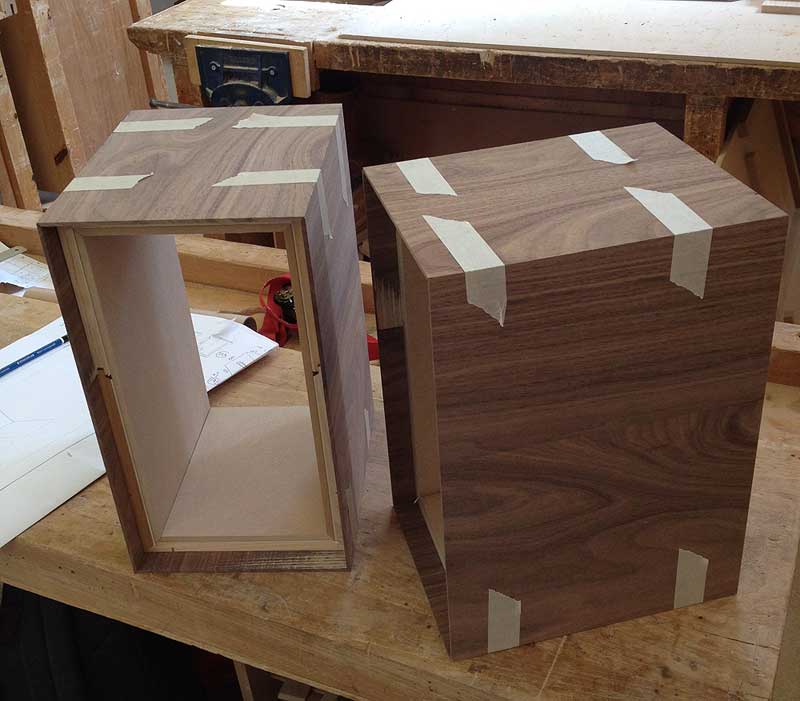
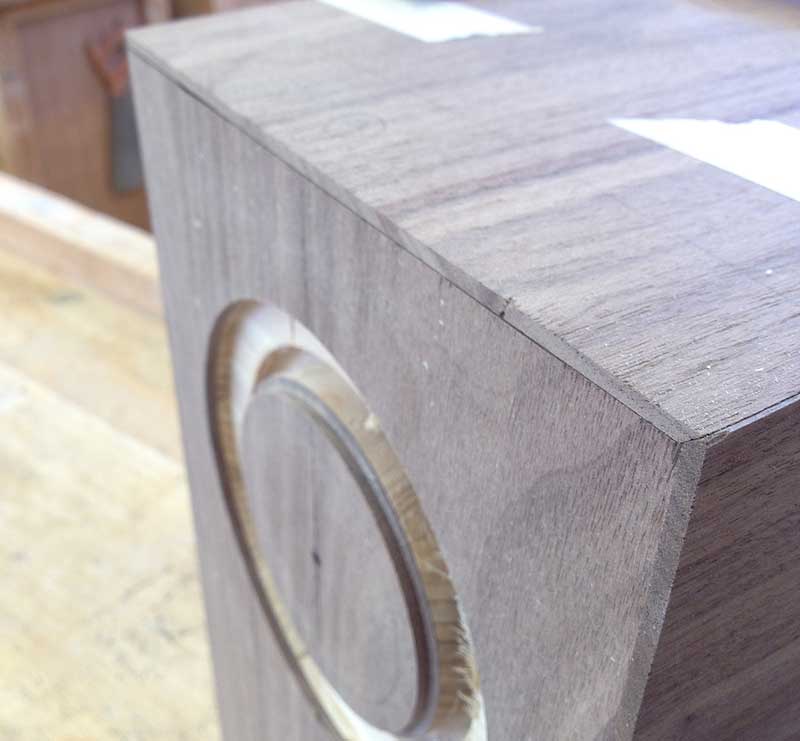
- Status
- This old topic is closed. If you want to reopen this topic, contact a moderator using the "Report Post" button.
- Home
- Loudspeakers
- Full Range
- Alpair 7.3 Bookshelf Bass Reflex?
